Freezers are common kitchen appliances, but you still need to know a few things about them. Before you go out and spend a fortune, it’s a good idea to have an understanding of how freezers operate. Apart from keeping your food fresh, freezers should also be cost-efficient. This means that they should not use too much electricity or defrost for very long.
Most people no longer need to worry about defrosting their freezers manually anymore. This process automatically happens. Most freezer models have a defrost cycle that lasts for approximately 25 to 45 minutes. The freezer can defrost once or twice a day.
If you are wondering how this all happens, continue reading. This article will explain the process and its purpose. We’ve researched thoroughly to give you clear answers to additional questions you may have about a freezer's defrost cycle.
NOTE: WE MAY GET A COMMISSION IF YOU DECIDE TO MAKE A PURCHASE THROUGH THESE LINKS. THERE'S ADDITIONAL NO COST TO YOU. CHECK THE BOTTOM OF THE PAGE FOR MORE INFORMATION.

The purpose of a defrost cycle
For food to be kept safe, most freezers maintain a temperature of -10 to 10 degrees Fahrenheit. The evaporator (what keeps the freezer cold) regulates the temperature. As you open and close a freezer, moisture finds its way in and condenses into water. Once this happens, the water turns to frost on the evaporator’s coils.
This could lead to a build-up of ice in the freezer. Since the evaporator coil is covered in ice and can’t cool the freezer, your food won’t remain fresh. Defrosting helps avoid this issue altogether.
In the latest models, defrosting happens at time-based intervals or automatically. It could also happen based on the usage of your freezer. This saves you time and energy.
What Processes Take Place During A Defrost Cycle?
Once the evaporator is covered in ice, it’ll get heated by the defrost mechanism. This aids in melting the water in a short amount of time. The water could quickly evaporate if it isn’t a lot. Otherwise, it usually drains through a duct at the back of the freezer. This process is controlled by an electronic or electric timer.
The timer could be set at intervals to defrost the freezer. This might be every 6, 8, 12, or 24 hours. When the temperature of the evaporator exceeds a certain limit, 40 degrees Fahrenheit or more, the defroster comes on.
The fans inside the freezer circulate air in the compartment keeping food fresh. But during defrosting, the fans don’t work in the freezer compartment to prevent the warm air from getting to the food compartment.

The positioning of the cooling elements in your freezer allows them to be heated for a shorter period without heating the contents of the freezer. Not all models use electric timers. Some freezers use hot gas in the condenser instead, which is mostly found in commercial freezers. The hot gas heats the evaporator, defrosting it faster.
New computerized freezers monitor the number of times the door is opened. This information is then optimized to regulate the defrost intervals.
How long does it take to defrost Freezer coils?
This solely depends on the amount of ice build-up on them. For manually maintained freezers, it may take up to 24 hours for the coils to defrost completely. Once you turn off the freezer and turn the thermostat to zero, open the door and lay towels or a pan under the freezer to collect water.
Don’t scrape the coils. This could damage them. A manually maintained freezer should be defrosted when there’s a quarter of an inch of ice build-up on the walls. This will maintain the efficiency of the freezer.
How warm does a freezer get on a defrost cycle?
When the defrost cycle starts, your freezer could get warm. The temperature rises from 20 to 45 degrees Fahrenheit, although not for long. It could last from 18 to 30 minutes. It all depends on the timer installed in the appliance.
Don’t panic! This helps the water to quickly evaporate when it gets to the heater. Remember, the amount of time may vary during each cycle.
What happens when a defrost timer goes bad?
A defrost timer is supposed to shut off the compressor and the fan motors. It should regulate intervals at which the evaporator gets rid of frost. Failure to control these intervals leads to excess frost building up on the coils. The ice on the evaporator coils reduces the airflow in the freezer. This is when it breaks down in the cooling mode. Should the defrost timer go bad at the defrost mode, you can expect the following:
- All ice melts. This makes the compartment warm. It even makes the appliance warm to the touch from the outside.
- Sometimes the freezer’s temperature could be fluctuating. This occurs when the timer keeps going on and off. This is a sure indicator that the timer is no longer working as it should.
- Another thing to look out for is a sudden high consumption of electricity. When the timer is working irregularly, energy consumption becomes erratic.
Before replacing the timer with a new one, though, test it for continuity. The test can be done using a multimeter. But this is when you should be on the lookout especially if the appliance isn’t new.
Click here to see this multimeter on Amazon.
In Closing
Free-standing freezers and refrigerators need to defrost to help keep our food fresh. This also helps the freezer last longer.
You may not want to get rid of your old freezer for sentimental reasons, or it may not be financially viable. Whichever the reason may be, if you keep it in good condition, it will continue serving you. The key to a freezer’s longevity is defrosting it regularly.
Older models may need longer cycles, whilst the newer ones need shorter ones. The process as we now understand may be manual as well as automatic. As long as you understand what to expect during the defrost cycle, you are good to go!




![Woman hand open plastic white container drawer in new refrigerator. How To Put A Freezer Drawer Back In [Inc. For Specific Brands]](https://forfreezing.com/wp-content/uploads/2021/09/Woman-hand-open-plastic-white-container-drawer-in-new-refrigerator.-How-To-Put-A-Freezer-Drawer-Back-In-Inc.-For-Specific-Brands-600x400.png)